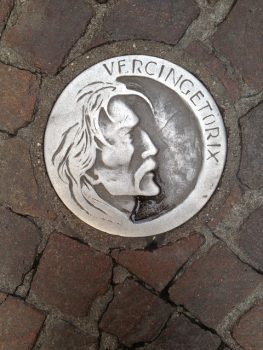Visiting Ancient France: The Battle of Alesia Posted by Elizabeth Schmermund on Apr 21, 2018 in Culture
One of the most important ancient battles that occurred during the Gallic Wars took place in Alésia, France. Known in French as le siège d’Alésia, this battle pitted Roman forces, led by Julius Caesar, against the Gauls (the Celtic tribe that inhabited the region from 5th century BCE to the 5th century CE), led by the chieftan Vercingétorix. The Romans’ decisive victory signaled the end of Gallic rule in modern-day France, as well as the beginning of the assimilation of the Gauls to Roman culture.
If the Gauls had ended up winning this battle, we can imagine that France would be very different today. After all, French has evolved from the language of the victors (Latin) and not of the Gauls. Yet, despite the importance of the battle, few people know about it today. The French government has attempted to change this in recent years, by opening an educational and tourist site at the site of the Battle of Alesia, called Le MuséoParc Alésia.
According to the website, Le MuséoParc Alésia consists of three different sites, including (in French):
- le Centre d’interprétation qui présente le contexte, le déroulement et les conséquences de la bataille d’Alésia pour les Gaulois et pour les Romains,
- les vestiges de la ville gallo-romaine d’Alésia,
- la statue de Vercingétorix érigée par Napoléon III.
- An interpretation center that offers the context, events, and consequences of the Battle of Alesia for the Gauls and the Romans,
- The ruins of the Gall0-Roman village of Alesia,
- The statue of Vercingétorix erected by Napoléon III.
According to historians and archeologists, the Battle of Alesia took place a Alise-Sainte-Reine, a small commune where the site is now located. It was here that the battle took place in 52 BCE, culminating in a long siege of the fortified village of Alesia. Julius Caesar ordered his troops to construct a wall around the village where Vercingétorix and his troops were located. Many men, women, and children starved during the siege. Finally, Vercingétorix told Caesar that he would surrender if his men were spared. Julius Caesar agreed, and triumphantly brought Vercingétorix back to Rome in chains, where he was later executed. This victory provided Julius Caesar with enough fame, support, and spoils from the war to embark on the civil wars that cemented his dictatorship.
Reference to this battle and to Vercingétorix can be found throughout France. Streets in Paris and elsewhere are named after Vercingétorix and Alésia, and many French schoolchildren have been introduced to Vercingétorix and the Gauls through the popular comic Astérix le Gaulois.
You can find out more about Le MuséoParc Alésia at its official website (https://www.alesia.com). And, next time you’re in the Burgundy region of France, make sure to visit!

Build vocabulary, practice pronunciation, and more with Transparent Language Online. Available anytime, anywhere, on any device.





Comments:
Joseph T. Madawela:
i wonder what the french words and its gaulish equivalents are. imagine a parallel world where wewill be learning Gallo-French
Elizabeth Schmermund:
@Joseph T. Madawela Thanks for your comment, Joseph! Your thought got me thinking…and helped inspire this week’s post. Thank you!
Elizabeth Schmermund:
@Joseph T. Madawela Thanks for your comment, Joseph! Your thought got me thinking…and helped inspire this week’s post. Thank you!